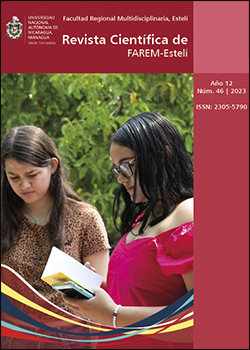Teaching role in the hybrid model: symbiosis of continuous learning with conventional distance education
DOI:
https://doi.org/10.5377/farem.v12i46.16478Keywords:
Teaching role, hybrid model, self-learning, remote teaching, digital competenceAbstract
Information and Communication Technologies (ICT) as well as Learning and Communication Technologies (LCT) are used as support resources for the strengthening of educational processes, even more so in distance pedagogical mediation. Learning environments are combined with face-to-face and virtual spaces, where a kind of hybrid learning emerges, so that communication networks play an important role in the continuity of interaction between teacher and student. The purpose of this research project is to design a methodological proposal for the teaching role in the hybrid modality for secondary education in Honduras during the period 2022-2023. This methodological proposal involves taking up the importance of the teaching role in the hybrid model as a continuous learning strategy, as well as the student profile in these learning spaces. The research focuses on the mixed approach, due to the implications in the processes of collecting, analyzing and linking quantitative-qualitative data. It is based on the sequential explanatory method, characterized by two stages: the first one in which quantitative data are analyzed and the second one where qualitative data are collected and evaluated. The information will be taken from primary sources which are the teachers and students of the twelfth grade of the Instituto Técnico Vocacional del Sur. The quantitative analysis of the information will be carried out using the Statical Package for the Social Sciences (SPSS) software, version 2.5, and the qualitative analysis through the corresponding analysis matrix.
Downloads
References
Bernal Torres, C. A. (2010). Metodología de la investigación (Tercera ed.). Colombia: PEARSON EDUCACIÓN.
Blog tecnológico Bilib. (19 de 04 de 2021). Centro de desarrollo de competencias digitales de Castilla-La Mancha. Obtenido de https://www.bilib.es/actualidad/blog/noticia/articulo/competencias-digitales-que-son-para-que-sirven-y-como-profundizar-en-tus-habilidades-con-las-tecno/
Camacho, L. J. (2014). Nuevos roles de los docentes en la educación superior: hacia un nuevo perfil y modelo de competencias con integración de las TIC. Ciencia y Sociedad, 601-640.
Comisión Europea, Centro Común de Investigación. (2017). Marco europeo para la competencia digital de los educadores: DigCompEdu. Y, Punie, editor. Oficina de publicaciones. doi:10.2760/178382
Delgado, P. (23 de Junio de 2020). Observatorio del Instituto para el futuro de la Educación Tecnológico de Monterrey. Obtenido de https://observatorio.tec.mx/edu-news/aprendizaje-sincronico-y-asincronico-definicion
Díaz Vivas, J. (2012). Modelos pedagógicos en educación a distancia. REDHECS, 86-113.
Escala, M. N. (2021). Competencias y herramientas digitales para el docente en el contexto COVID-19. Universidad Internacional del Ecuador.
Flores, R. (2005). Pedagogía del conocimiento. Modelos pedagógicos y enseñanza de las ciencias. (Segunda ed.). Colombia: McGraw Hill Interamericana. Obtenido de https://www.unipamplona.edu.co/unipamplona/portalIG/home_9/recursos/general/12022015/pedagogia_del_conocimiento.pdf
Fracica Naranjo, G. (1988). Modelo de simulación en muestreo. Bogotá, Colombia: Universidad de La Sabana.
García Aretio, L. (2018). Blended learning y la convergencia entre la educación presencial y a distancia. RIED. Revista Iberoamericana de Educación a Distancia, 8-18. doi:https://doi.org/10.5944/ried.21.1.19683
Garcia Mathewson, T. (06 de Agosto de 2020). Enfoque Educación. Obtenido de https://blogs.iadb.org/educacion/es/aprendizajeautodirigido/
Morales Irizarry, C. R. (2006). La importancia del Diseñador Instruccional en el diseño de cursos en línea. Revista DIM: Didáctica, Innovación y Multimedia(3). Obtenido de http://dimglobal.net/revistaDIM3/Articulos/CMorales.pdf
Moreira, M. (2019). La enseñanza universitaria digital. Fundamentos pedagógicos y tendencias actuales. Obtenido de https://riull.ull.es/xmlui/bitstream/handle/915/13247/La%20ense%C3%B1anza%20universitaria%20digital%20-%20Manuel%20Area-Moreira%20%28marzo%202019%29.pdf?sequence=1&isAllowed=y
Quintero, M. (2009). Diseño e implementación de objetos de aprendizaje reutilizables basados en estándares de especificación como estrategia de enseñanza virtual. Tesis de grado, Universidad de Los Andes, Venezuela, Mérida. Obtenido de http://repositorioslatinoamericanos.uchile.cl/handle/2250/216145
Rodríguez Cepeda, R. (2018). Los modelos de aprendizaje de Kolb, Honey y Mumford: implicaciones para la educación en ciencias. Sophia, 51-64. doi:http://dx.doi.org/10.18634/sophiaj.14v.1i.698
SIED FHyCS - UNAM. (2021). Educación en ambientes híbridos: hacia el diseño de un sistema educativo situado, remoto y en red. Compendio, México.
Tribó Travería, G. (2008). El nuevo perfil profesional de los profesores de secundaria. Educación XX1, 183-209.
Published
Issue
Section
License
Copyright (c) 2023 Revista Científica de FAREM-Esteli

This work is licensed under a Creative Commons Attribution-NonCommercial-ShareAlike 4.0 International License.



